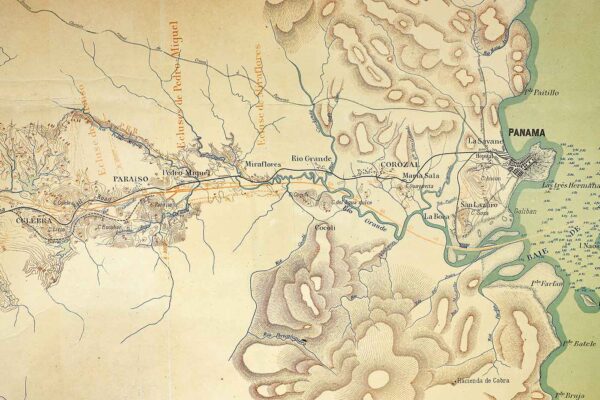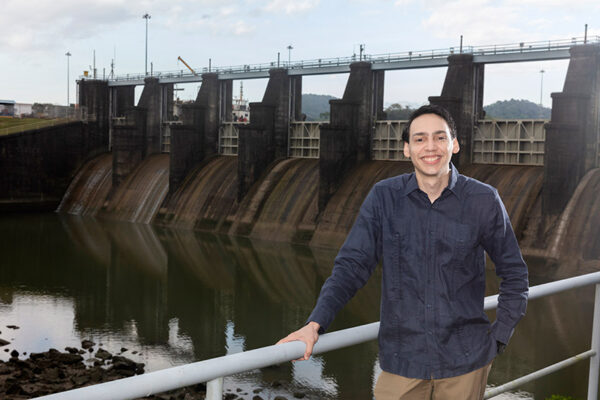A tale to tell: The environmental history of the Rio Grande
The Grande River is a memory in the Panama Canal area. Maps from the 19th century show how its course […]
The Grande River is a memory in the Panama Canal area. Maps from the 19th century show how its course meandered from the area of the old town of Emperador, in Arraiján, to flow into the current Pacific entrance of the Canal. This giant was dammed to create Lake Miraflores, an artificial water reservoir for the operation of the waterway and the supply of the population of the then Canal Zone and Panama City.
The Grande River, before dissolving in the memory of the Canal and in our environmental memory, was the main source of water for Panama City, which precisely this January, celebrates its 349th anniversary in its current location, since its transfer from the site of Panama Viejo.
With the Miraflores spillway that dams the waters of the then Grande River as a backdrop, we talked with Francisco Javier Bonilla, a young Panamanian, researcher and historian attached to the Center for Historical, Anthropological and Cultural Research (Cihac-Aip), about the history of the Grande River.

Who is Francisco Javier Bonilla, why environmental history and the Grande River?
“I was born in Panama City and grew up on the banks of the Matias Hernandez River in Parque Lefevre. I finished my high school studies at the Episcopal College of Panama with the idea of migrating to the United States and the dream of becoming a lawyer; however, the comprehensive education I received at the public university in Kentucky led me towards history. I persistently found that the issues that attracted me, took their fundamental features in long-standing processes, such as racial discrimination and climate change; all of them with their interpretation in history. I then decided to undertake my master’s thesis on the environmental history of the Rio Grande.
This opened me up to doctoral funding, opting for Carnegie Mellon University in Pittsburgh, Pennsylvania for a program on urban water and its infrastructure. The Rio Grande River has an unknown history which I consider key to understanding the Canal and the operation of one of the world’s largest water works on Panamanian soil”.
Why your interest in water and how has it evolved?
“I was familiar with the history of rivers in the U.S., and decided to cover the history of the late Rio Grande, on the southern slope of the interoceanic waterway, because of its economic activity so important to the country. For my PhD in progress, I delved into the process by which water from the defunct river entered Panama City through an aqueduct, and exited along with rainwater and sewage to the sea. This led me to broaden my focus as a researcher, to be more than just a historian of rivers and transit.
A historian of rivers and inter-oceanic transit, but also to be a historian of public health and technology in the city. That perspective forced me to venture into issues of sanitary and hydraulic engineering, people’s rights to the city and the construction of its spaces.”

What have been your main findings in this environmental history of the Panama Canal, our society and the administration of water resources?
“The history of the Rio Grande, like that of the Chagres, shows us how the role of the isthmus has been changing since the organization of the international inter-oceanic transit, for more than 300 years. It shows us that the landscapes of the route were transformed to allow flows of goods and people. Because of its location on the Pacific slope, the Rio Grande River has much to say about the urban geography of the main city of the metropolitan region. Its physical configuration, the quality of its water, and ultimately the territorial control of its basin, are essential dimensions to understand how rivers participate in the sanitation process, the construction of the Miraflores and Pedro Miguel Locks and the current operation.
My doctoral research will propose a new way of understanding the sanitary and hygienic state of terminal cities. The new narrative will try to capture the city of Panama, which, with the Canal, was just emerging into modernity, with a little more rigor than the vision of the famous travelers of the 19th century, who only highlighted the lack of sanitation and road drainage. Although the Zonian authorities thought that they were the ones who brought modernization to Panama and Colon, the truth is that the Panamanian municipalities during the Colombian period had been involved for decades in efforts to counteract the urban dangers and the threats of tropical and non-tropical diseases that decimated the population for decades. Long before the French Canal works began, Panamanians already had so-called Material Progress, Hygiene and Sanitation Boards and active public works authorities. Panamanians saw themselves as modern citizens even before the Isthmian Canal Commission began its anti-mosquito campaign and built an aqueduct, a sewer system, and a new landscape with “sanitary” landfills such as Balboa or Tabernilla. In fact, Panamanians of different strata were not immobilized with strangeness by these novelties, but saw them as a displacement of a well-established institutional authority subject to their influence, albeit unevenly inserted.”
What would you tell your contemporaries about the need to delve deeper into environmental history?
“Youth in Panama, like youth around the world, show an urgent concern for our future on the planet due to climate change. Locally, the destruction of forests and the contamination of water sources by mining will be one of our greatest challenges. Our generation is disillusioned with the way in which politics is understood by the current actors, or by what they manage to understand. We are exposed to an environmental catastrophism capable of rendering us inert in the face of the seriousness of the challenges. We must not lose sight of the fact that the environment is the result of human work processes and social mobilizations, and therefore, changing it necessarily entails building a different society.
Politics becomes the only way to act on this scale and have a democratic influence on the environment and within our society. It is therefore urgent to broaden the understanding of “the political”. This will allow us to formulate alternatives based on the history we are investigating and the futures we can imagine. For the latter, literature, fiction, commitment, education and research excellence are essential”.